Dún Laoghaire: Difference between revisions
m clean up, typos fixed: a 5th century → a 5th-century, three day → three-day |
No edit summary |
||
| Line 8: | Line 8: | ||
|population=23857 | |population=23857 | ||
|census year=2006 | |census year=2006 | ||
|post town=Dún Laoghaire | |||
|postcode=A96 | |||
|LG district=Dún Laoghaire–Rathdown | |LG district=Dún Laoghaire–Rathdown | ||
|constituency=Dún Laoghaire | |constituency=Dún Laoghaire | ||
|website=http://www | |website=http://www.dun-laoghaire.com | ||
}} | }} | ||
'''Dún Laoghaire''' ({{IPA|d̪ˠuːn̪ˠ ˈɫeːrʲə}}) is a suburban seaside port town in [[County Dublin]]. It is about {{convert|12|km|1|}} south of [[Dublin]] city centre. | '''Dún Laoghaire''' ({{IPA|d̪ˠuːn̪ˠ ˈɫeːrʲə}}) is a suburban seaside port town in [[County Dublin]]. It is about {{convert|12|km|1|}} south of [[Dublin]] city centre. | ||
Latest revision as of 16:38, 18 May 2016
| Dún Laoghaire | |
| County Dublin | |
|---|---|
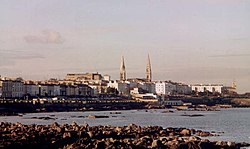
| |
| Location | |
| Grid reference: | O241284 |
| Location: | 53°18’-0"N, 6°8’24"W |
| Data | |
| Population: | 23,857 (2006) |
| Post town: | Dún Laoghaire |
| Postcode: | A96 |
| Local Government | |
| Council: | Dún Laoghaire–Rathdown |
| Dáil constituency: |
Dún Laoghaire |
| Website: | http://www.dun-laoghaire.com |
Dún Laoghaire (d̪ˠuːn̪ˠ ˈɫeːrʲə) is a suburban seaside port town in County Dublin. It is about 7.5 miles (12.0 km) south of Dublin city centre.
It is a major port of entry from Great Britain, though less busy since the Port of Dublin took over much of the traffic
Name
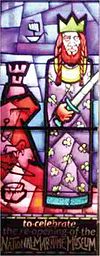
The town's name was formerly written Dunleary, and from 1821 to 1920 it was named Kingstown. After Irish independence, royal symbols and names, such as "Kingstown", were effaced and the Gaelic spelling of Dunleary was adopted, though pronounced in the same way.
A 1920s limerick made light of this language nationalism:
There once was a man from Dún Laoghaire
Who pronounced an interesting theoghaire
that the language of Erse
Has a shortage of verse
as the spelling makes poets so weoghaire
The name Dún Laoghaire means "fort of Laoghaire". This refers to Lóegaire mac Néill (or in modern Irish spelling Laoghaire Mac Néill), a 5th-century High King of Ireland, who chose the site as a sea base from which to carry out raids on Great Britain and Gaul. Traces of fortifications from that time have been found on the coast, and some of the stone is kept in the National Maritime Museum of Ireland.
The name is sometimes unofficially spelt in modern Irish orthography as Dún Laoire.[1] In rare cases, the old spelling Dunleary is seen.[1][2]
History
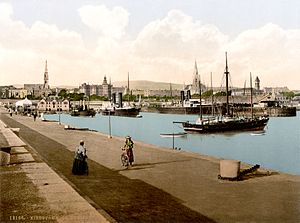
The present town of Dún Laoghaire dates from the 1820s. An earlier Dunleary village was located around the area where "The Purty Kitchen" pub is now located (sometimes mapped as "Old Dunleary"). Dunleary had a coffee house, and a small cove, both of which are shown on a number of old maps, and it may have had a salt mine (Salthill is close by). At that time, the area where the town is now stands was a craggy, rocky pasture area with some quarries.
The events of the night of 18/19 November 1807 were to lead eventually to the transformation of the area. On that night, the troopships, the Prince of Wales, and the Rochdale, both of which had departed from Dublin, were driven on the rocks between Blackrock and Dún Laoghaire with the combined loss of over 400 lives. This disaster gave new impetus to an existing campaign for a new harbour to be constructed near Dublin. By 1816, the legislation was passed authorising the construction of what is now called the "West Pier". When King George IV came to visit the new port under construction in 1821, the name Dunleary was dropped in favour of the name "Kingstown"; the town returned to its former name in 1920, in the lead-up to the creation of the Irish Free State.
Some maps show the commencement of a small town centre along what is now Cumberland Street, close to the junction with York Road, but from the 1820s the harbour brought new business to the area, and a new town centre began to form along Georges St. That street may originally have been laid out as a military road connecting the Dún Laoghaire Martello Towers—one at the "Peoples Park", the other near the end of the West Pier—both of which have long disappeared.
Ireland's first railway from Dublin to Kingstown, opened for business in 1834, terminated near the West Pier. It established Kingstown as a preferred suburb of Dublin, and led to the construction of elegant residential terraces. By 1844 the "Atmospheric Train" (designed by Robert Mallet) connected Kingstown to Dalkey, leading to further development. The Atmospheric Train ceased in 1854, but was replaced by the extension of the railway, which was subsequently extended to the ferryport of Rosslare. The opening of the railway from Dublin saw Kingstown become a Victorian era seaside resort.
The 59th (2nd North Midland) Division disembarked at Kingstown in April 1916 and marched up the road to Dublin, in order to crush the Easter Rising. Adjacent to the Carlisle Pier and overlooked by the National Maritime Museum of Ireland, there is an anchor, recovered from the wreck of the mailboat RMS Leinster which was torpedoed over the Kish Bank in 1918, with the loss of over 500 lives.
The main road to Dublin, through Monkstown village and Blackrock, was the sole road connection to the city of Dublin until 1932. In that year, the Eucharistic Congress, held in Dublin brought thousands of visitors to Dublin, and plans indicated that most of them would come through Dún Laoghaire. The road was considered inadequate, and a new coast road was created by connecting some short segments of road and closing some gardens. This road is now Seapoint Avenue. An agreement with the local residents to restore the area to pre-congress condition was never fulfilled.
Dún Laoghaire was hit by stray German bombs during Second World War, a couple of bombs landing near the People's Park at Rosmeen Gardens. Damage from the bombs was limited to buildings.
About the town
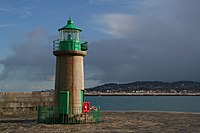
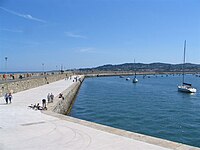
The Dún Laoghaire town hall clock face is a characteristic of the town, and was always a welcoming sight to the many Irish emigrants whenever returning to Ireland on the Holyhead to Dún Laoghaire ferry: on a cold winters morning on the ferry coming into Dún Laoghaire the tired and weary traveller, often having travelled overnight from London by train to Holyhead and then having faced a rough and - as was the case decades ago - rough crossing on the Irish Sea, would smile as they could see the town hall clock face through a thick morning fog. So, then, this almost iconic town hall clock face can serve as a good reminder of all those years past when Irish people had to leave their homeland to earn a living; a sadness once thought banished in the Ireland of today, but a recurrent theme in latter years.
The harbour, one of the largest in the country, and base for a now limited car ferry route to Great Britain, is notable for its two granite piers. The East Pier is particularly popular with walkers, and was featured in the 1996 film Michael Collins]], in which Collins (played by Liam Neeson) and two colleagues are seen walking along a seaside promenade, which is actually the Dún Laoghaire East Pier. A band is seen playing on a bandstand in this scene, and this is the actual bandstand on the East Pier. The bandstand was restored to its original condition in 2010 by the Dún Laoghaire Harbour Company.[3]
It took 42 years to construct the harbour, from 1817 to 1859. The obelisk near the old ferryport terminal at the harbour commemorates the construction of this harbour.
A lighthouse was located at the end of the East Pier, while the new headquarters of the Commissioners of Irish Lights is located on Harbour Road.
South of the harbour is Scotsman's Bay, where there was a Victorian seaside amusement area, with walks, shelters and baths. The walks and shelters are largely intact. The Dún Laoghaire Baths have been derelict for many years, but were repainted in bright colours in 2012.[4] Plans for restoration of this area are much debated, and some of the more ambitious ideas have been highly controversial.
A traditional Victorian-style park, the People's Park, is at the eastern end of George's Street, and including still-functioning tea rooms.
At least one traditional "cabman's shelter" survives – these were small buildings built for the drivers of the horse-drawn taxis of Kingstown.
Community facilities include the Boylan Community Centre, the Dún Laoghaire Scout Den, and a community information service in the tower building of St Michael's Church.

Transport links
Dún Laoghaire is connected to central Dublin by the Dublin Area Rapid Transit ("DART") suburban railway, and is also a stop on the mainline rail service from Dublin to Wexford and Rosslare. An Aircoach service links the area with Dublin Airport 24 hours a day with stops at County Hall and the Royal Marine Hotel.
The Dublin and Kingstown Railway, constructed and opened in 1834, was the first ever railway in Ireland, built to standard gauge. This was followed by the Dalkey Atmospheric Railway, an extension of the D&K that opened in 1843 (also built to standard gauge), the first railway to have practical application of pneumatic power. In 1854, the Dublin, Wicklow and Wexford Railway took over both lines, converting both to Irish gauge and the latter to steam power, extending further south to Bray, County Wicklow, Wicklow, and eventually Wexford and Waterford as the Dublin and South Eastern Railway. In 1925, the DSER was amalgamated into the Great Southern Railways company, which lasted until 1944 when the railway was merged into CIÉ. Electrification arrived in 1984, and the suburban service was re-branded as DART service.
Ferry

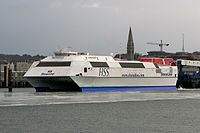
The town has a seasonal ferry connection across the Irish Sea to Holyhead in Anglesey.
Formerly, this was a year round service and constituted one of Ireland's main sea links to Great Britain.
Sport
Boating
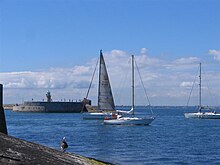
Dún Laoghaire harbour is home to six yacht clubs. From north (West Pier) to south (East Pier) they are the Dún Laoghaire Motor Yacht Club, the Sailing in Dublin Club, the Royal Irish Yacht Club, the Royal St George Yacht Club, the Royal Alfred Yacht Club, and the National Yacht Club. The Irish National Sailing School & Club, Ireland's largest sail training provider for adults and children alike is based at the foot of the West Pier.
The area to the north of the West Pier at Salthill Beach sees much windsurfing activity over the twelve months of the year.
St Michael's Rowing Club, one of the longest-established members of the East Coast Rowing Council, has its roots in the harbour here since the hobblers of the 18th and 19th centuries. The club itself has existed since the early 1920s and still resides in the Coal Harbour boat yard today. Members can regularly be seen rowing their traditional, clinker built skiffs around the harbour and Scotsman's Bay throughout the year.
Marina
The 820-berth marina is the largest in the country, and opened in 2001 following resistance for over 15 years by a group led by the late John de Courcy Ireland, the maritime historian. Following his death in April 2006, a 240-berth extension, involving an investment of €3 million, was approved in June 2006 by An Bord Pleanála; the project was completed in April 2007.
Golf
The town had a golf club from 1909 to 2007, but its members agreed to sell the course to housing developers and move to Ballyman Road, near Enniskerry in County Wicklow. The move occurred on 1 August 2007, to a purpose-built 96-acre site, with spectacular views over the Wicklow countryside including the Sugarloaf Mountain. The new course is one of the finest in County Dublin, and some people have dubbed the course "The D Club", in reference to Kildare's spectacular K Club.
Dún Laoghaire Golf Club’s 27-hole championship course has been designed by Hawtree to allow different combinations of the three nine-hole courses to be played. The championship courses played from the blue tees range from 7,156 yards to 6,869 yards, although with five sets of tees, the course provides an exhilarating challenge to both professional and club golfers alike.
The magnificent 5-star Clubhouse which incorporates a spectacular terrace with stunning panoramic views of the Wicklow Mountains has spacious locker, dining and bar facilities, meeting rooms and offices and is perfectly equipped to cater for any function. Its golf performance academy is one of Ireland’s leading teaching facilities and includes indoor swing studio, indoor putting studio, 13-bay driving range, dedicated pitching and chipping area, bunker area and gym. The Clubhouse incorporates a spectacular terrace with stunning panoramic views of the Wicklow Mountains.
Shopping and business
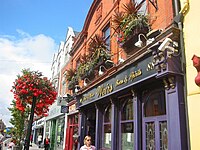
Dún Laoghaire has one main shopping street, George's Street, as well as two shopping centres: the Dún Laoghaire Shopping Centre and Bloomfields, the former dating from 1977. Recent years have seen some commercial development of the land around the George's Street area, including, notably, the old Pavilion Cinema and Theatre site opposite the town hall. There is a regular antiques fair held bi-monthly, on Sundays in the Royal Marine Hotel, near the harbour, and a weekly farmers market held in the People's Park on Sundays.
The town has a wide range of eating places and public houses, as well as more than one hundred other retail businesses, including famous high street shops such as Marks and Spencer, Penneys and Dunnes Stores.
The town is home to the head office of Ireland's largest supermarket operator, Tesco Ireland, whose stores previously anchored both major shopping centres in the town. But the one in Dún Laoghaire Shopping Centre which had been in operation since 1977, closed in May 2011 leaving only the one in Bloomfields.[5]
Dún Laoghaire also holds other company headquarters, such as those of Bord Iascaigh Mhara and Lionbridge Ireland.
There is an active Business Association, and a local Chamber of Commerce.
Tourism
Much of the town's early growth came from visitors from Dublin, and today there is one large hotel, heavily refurbished in 2007, the Royal Marine, along with several small hotels, and a number of bed-and-breakfasts.
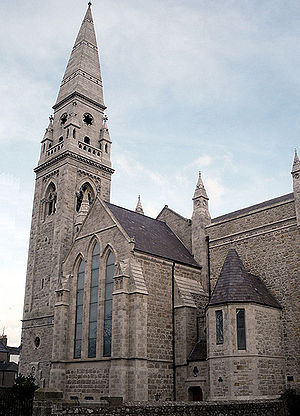
Bars and night life
Dún Laoghaire has 11 bars and 4 night clubs, mostly centred along the main street Georges Street Upper. They include “traditional Irish bars” like Farrell's, Walter's, Lion Bar, Weir's, McKenna's & Dunphy's.
Culture
Dún Laoghaire has associations with many leading cultural figures, most notably James Joyce and Samuel Beckett.
Joyce's sojourn at Kingstown, staying with Oliver St John Gogarty in a Martello tower in nearby Sandycove he later immortalised in the opening chapter of Ulysses. This tower, now known as the James Joyce Tower, contains a small museum.
Samuel Beckett came from nearby Foxrock and is said to have experienced an artistic epiphany, alluded to in his play Krapp's Last Tape, while sitting on the end of one of Dún Laoghaire's piers. A bronze plaque marks the spot.
The baritone Frederick Ranalow, famed for his close to 1,500 performances in The Beggar's Opera, was born in Kingstown, although he moved to London at an early age.
The famed black equestrian and circus owner Pablo Fanque, immortalised in The Beatles' song Being for the Benefit of Mr. Kite!, performed here for one week during a long engagement in Dublin, in 1850.[6]
Dún Laoghaire was previously home to the Festival of World Cultures, a three-day festival dedicated to music from all corners of the globe. It was one of the largest music festivals in Ireland attracting over a quarter of a million visitors to the town over a weekend in August. For nine years (2001–2010), the festival was a huge success, but unfortunately it was decided by the local council to stop hosting the festival as in 2010 there were large losses.[7] According to the DLR Festival Website "Panning will begin shortly for a Festival of World Cultures in 2012" meaning a return of the World cultures festival is promanant.[8]
A new purpose-built theatre, the Pavilion, opened its doors in 2000. Built on the site of the 1903 'Kingstown Pavilion', it serves as the Municipal Theatre for Dún Laoghaire-Rathdown, and is a host venue for a number of important festivals, including the International Puppet Festival, and, recently, the Dublin Theatre Festival.
St Michael's Church is home to the longest-running series of organ concerts in Ireland, featuring the famous 1974 organ by Rieger Orgelbau which is the only organ of its type in Ireland.
The National Maritime Museum of Ireland is housed in Mariners' Church, which formerly served the Royal Navy. It is situated directly inland from the east pier. The building has been completely renovated and reopened.[9] The nearby "pond", (actually a water reservoir which served steam driven ships) and bowling green are being replaced by the new central library building.
A Carnegie library opened in 1912 is located on Library Road. It was formerly the Kingstown Corporation library headquarters. Work has started (April 2012) on a new central library to be built close to the Maritime Museum.[10]
Off Library Road there is the Oratory of the Sacred Heart (4m x 6m), described as a "gem of Celtic Renaissance art".[11] It was created by members of the former Dominican Convent now replaced by the Tesco anchored "Bloomfield" Shopping Centre.
Outside links
- Dún Laoghaire Town – EU Brand Project
- Dún Laoghaire Borough Historical Society
- Dún Laoghaire Harbour Company
- Dún Laoghaire Lifeboat Station
- Festival of World Cultures
- History of the Holyhead to Dún Laoghaire ferry service
- Pavilion Theatre
- 8th Port Sea Scouts of Dún Laoaghaire
- Dún Laoaghaire Golf Club
References
- ↑ 1.0 1.1 Dun Laoire? Dun Leary? Or Dun Laoghaire? How the harbour town got its name. Dunlaoghaire.ie
- ↑ "Dunleary Road". Bunachar Logainmneacha na hÉireann. http://www.logainm.ie/1407365.aspx. Retrieved 2012-02-10.
- ↑ Dún Laoghaire Harbour Company – Bandstand and shelter restored
- ↑ "Dún Laoghaire Baths get much needed lick of paint". RTÉ News. 3 April 2012. http://www.rte.ie/news/2012/0403/dun-laoghaire-baths-get-much-needed-lick-of-paint.html. Retrieved 3 April 2012.
- ↑ Tesco to close store in Dún Laoghaire centre, The Irish Times, 11 May 2011
- ↑ The Freeman's Journal and Daily Commercial Appeal, 17 June 1850.
- ↑ No Festival of World Cultures in 2011?
- ↑ [1]
- ↑ "National Maritime Museum of Ireland". News. Maritime Institute of Ireland. http://www.mariner.ie/news. Retrieved 7 May 2012.
- ↑ Dún Laoghaire-Rathdown County Council – press release
- ↑ "Heritage Week 2008 in Dún Laoghaire-Rathdown County". Dún Laoghaire-Rathdown County Council. http://www.dlrcoco.ie/heritage/week.htm. Retrieved 2009-05-22..
| ("Wikimedia Commons" has material about Dún Laoghaire) |
